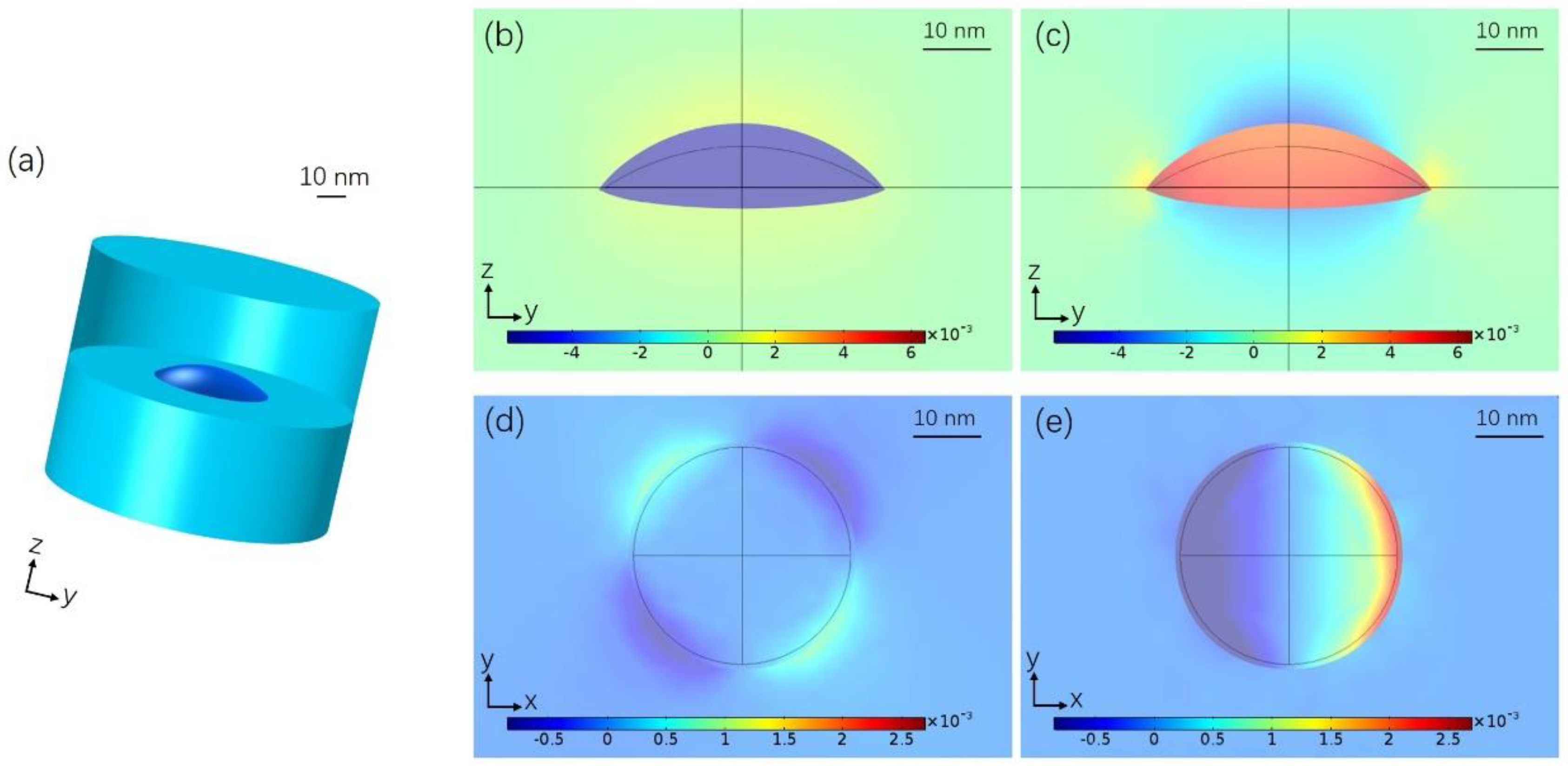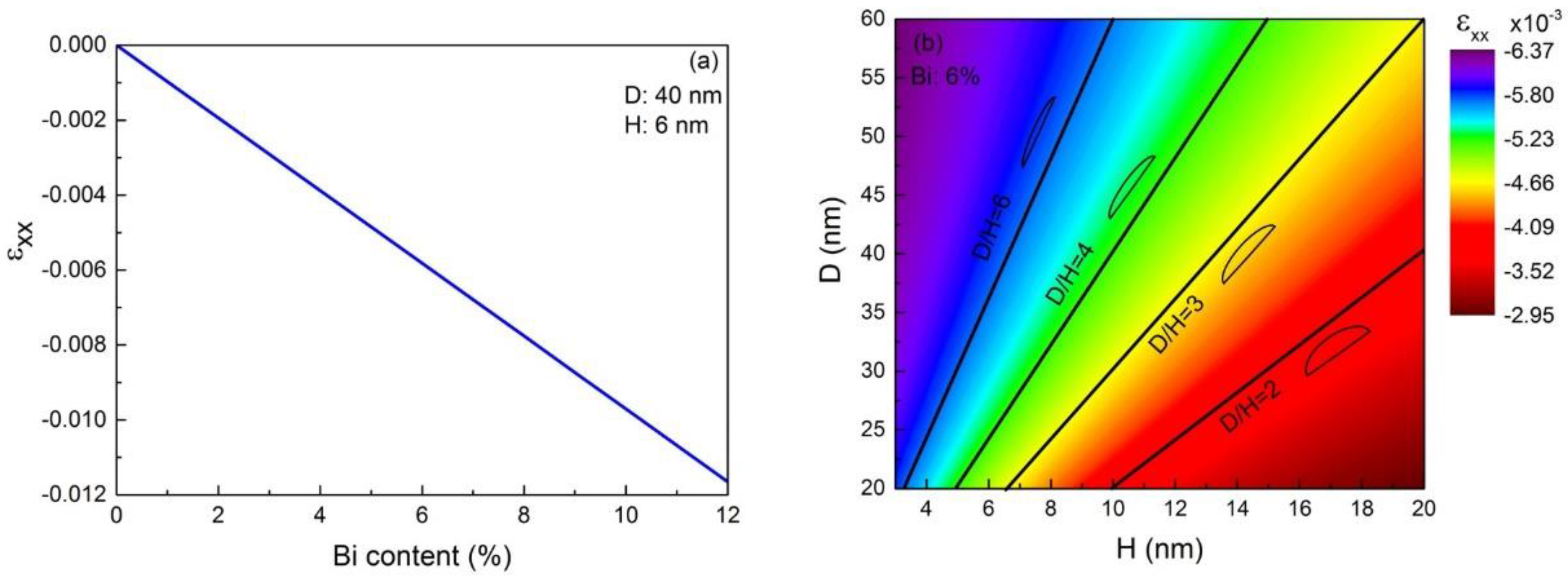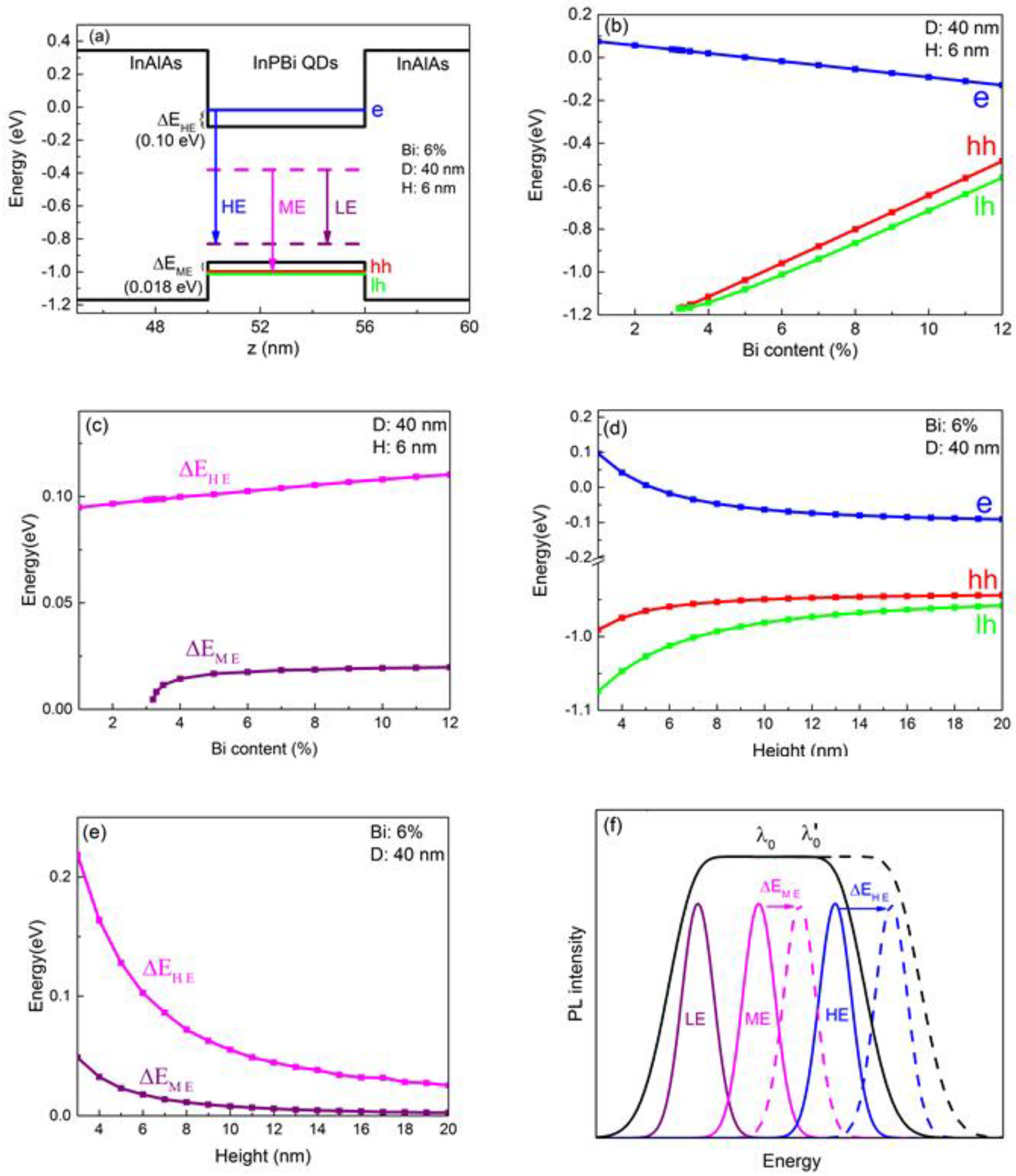InPBi Quantum Dots for Super-Luminescence Diodes
Abstract
1. Introduction
2. Methods
3. Results and Discussions
3.1. Strain Analysis
3.2. Band Structure
4. Conclusions
Author Contributions
Funding
Conflicts of Interest
References
- Sweeney, S.; Jin, S. Bismide-nitride alloys: Promising for efficient light emitting devices in the near-and mid-infrared. J. Appl. Phys. 2013, 113, 043110. [Google Scholar] [CrossRef]
- Marko, I.; Batool, Z.; Hild, K.; Jin, S.R.; Hossain, N.; Hosea, T.J.C.; Petropoulos, J.P.; Zhong, Y.; Dongmo, P.B.; Zide, J.M.O.; et al. Temperature and Bi-concentration dependence of the bandgap and spin-orbit splitting in InGaBiAs/InP semiconductors for mid-infrared applications. Appl. Phys. Lett. 2012, 101, 221108. [Google Scholar] [CrossRef]
- Tiedje, T.; Young, E.C.; Mascarenhas, A. Growth and properties of the dilute bismide semiconductor GaAs1-xBix a complementary alloy to the dilute nitrides. Int. J. Nanotechnol. 2008, 5, 963–983. [Google Scholar] [CrossRef]
- Dimroth, F. High-efficiency solar cells from III-V compound semiconductors. Phys. Status solidi C 2006, 3, 373–379. [Google Scholar] [CrossRef]
- Rajpalke, M.K.; Linhart, W.M.; Birkett, M.; Yu, K.M.; Alaria, J.; Kopaczek, J.; Kudrawiec, R.; Jones, T.S.; Ashwin, M.J.; Veal, T.D. High Bi content GaSbBi alloys. J. Appl. Phys. 2014, 116, 043511. [Google Scholar] [CrossRef]
- Francoeur, S.; Seong, M.J.; Mascarenhas, A.; Tixier, S.; Adamcyk, M.; Tiedje, T. Band gap of GaAs1−xBix, 0 < x < 3.6%. Appl. Phys. Lett. 2003, 82, 3874–3876. [Google Scholar]
- Ma, K.Y.; Fang, Z.M.; Jaw, D.H.; Cohen, R.M.; Stringfellow, G.B.; Kosar, W.P.; Brown, D.W. Organometallic vapor phase epitaxial growth and characterization of InAsBi and InAsSbBi. Appl. Phys. Lett. 1989, 55, 2420–2422. [Google Scholar] [CrossRef]
- Jean-Louis, A.; Hamon, C. Propriétés des alliages InSb1−xBix I. Mesures électriques. Phys. Status Solidi B 1969, 34, 329–340. [Google Scholar] [CrossRef]
- Kopaczek, J.; Kudrawiec, R.; Polak, M.P.; Scharoch, P.; Birkett, M.; Veal, T.D.; Wang, K.; Gu, Y.; Gong, Q.; Wang, S. Contactless electroreflectance and theoretical studies of band gap and spin-orbit splitting in InP1−xBix dilute bismide with x ≤ 0.034. Appl. Phys. Lett. 2014, 105, L1283. [Google Scholar] [CrossRef]
- Alberi, K.; Wu, J.; Walukiewicz, W.; Yu, K.M.; Dubon, O.D.; Watkins, S.P.; Wang, C.X.; Liu, X.; Cho, Y.-J.; Furdyna, J. Valence-band anticrossing in mismatched III-V semiconductor alloys. Phys. Rev. B 2007, 75, 045203. [Google Scholar] [CrossRef]
- Fluegel, B.; Francoeur, S.; Mascarenhas, A.; Tixier, S.; Young, E.C.; Tiedje, T. Giant spin-orbit bowing in GaAs1−xBix. Phys. Rev. Lett. 2006, 97, 067205. [Google Scholar] [CrossRef] [PubMed]
- Berding, M.A.; Sher, A.; Chen, A.B.; Miller, W.E. Structural properties of bismuth-bearing semiconductor alloys. J. Appl. Phys. 1988, 63, 107–115. [Google Scholar] [CrossRef]
- Wang, K.; Gu, Y.; Zhou, H.F.; Zhang, L.Y.; Kang, C.Z.; Wu, M.J.; Pan, W.W.; Lu, P.F.; Gong, Q.; Wang, S.M. InPBi Single Crystals Grown by Molecular Beam Epitaxy. Sci. Rep. 2014, 4, 5449. [Google Scholar] [CrossRef] [PubMed]
- Wu, X.; Chen, X.; Pan, W.; Wang, P.; Zhang, L.; Li, Y.; Wang, H.; Wang, K.; Shao, J.; Wang, S. Anomalous photoluminescence in InP1−xBix. Sci. Rep. 2016, 6, 27867. [Google Scholar] [CrossRef] [PubMed]
- Pan, W.; Wang, P.; Wu, X.; Wang, K.; Cui, J.; Yue, L.; Zhang, L.; Gong, Q.; Wang, S. Growth and material properties of InPBi thin films using gas source molecular beam epitaxy. J. Alloys Compd. 2016, 656, 777–783. [Google Scholar] [CrossRef]
- Zhang, L.; Wu, M.; Chen, X.; Wu, X.; Spiecker, E.; Song, Y.; Pan, W.; Li, Y.; Yue, L.; Shao, J.; et al. Nanoscale distribution of Bi atoms in InP1−xBix. Sci. Rep. 2017, 7, 12278. [Google Scholar] [CrossRef] [PubMed]
- Liu, H.; Wang, T.; Jiang, Q.; Hogg, R.; Tutu, F.; Pozzi, F.; Seeds, A. Long-wavelength InAs/GaAs quantum-dot laser diode monolithically grown on Ge substrate. Nat. Photonics 2011, 5, 416. [Google Scholar] [CrossRef]
- Qian, L.; Zheng, Y.; Xue, J.; Holloway, P.H. Stable and efficient quantum-dot light-emitting diodes based on solution-processed multilayer structures. Nat. Photonics 2011, 5, 543. [Google Scholar] [CrossRef]
- Lent, C.S.; Tougaw, P.D.; Porod, W.; Bernstein, G.H. Quantum cellular automata. Nanotechnology 1993, 4, 49. [Google Scholar] [CrossRef]
- Wu, J.; Wang, Z.M. Quantum Dot Molecules; Springer: New York, NY, USA, 2014. [Google Scholar]
- Chikyow, T.; Koguchi, N. MBE growth method for pyramid-shaped GaAs micro crystals on ZnSe (001) surface using Ga droplets. Jpn. J. Appl. Phys. 1990, 29, L2093. [Google Scholar] [CrossRef]
- Vurgaftman, I.J.; Meyer, J.Á.; Ram-Mohan, L. Band parameters for III–V compound semiconductors and their alloys. J. Appl. Phys. 2001, 89, 5815–5875. [Google Scholar] [CrossRef]
- Shalindar, A.J.; Webster, P.T.; Wilkens, B.J.; Alford, T.L.; Johnson, S.R. Measurement of InAsBi mole fraction and InBi lattice constant using Rutherford backscattering spectrometry and X-ray diffraction. J. Appl. Phys. 2016, 120, 145704. [Google Scholar] [CrossRef]
- Yeh, C.N.; McNeil, L.E.; Nahory, R.E.; Bhat, R. Measurement of the In0.52Al0.48As valence-band hydrostatic deformation potential and the hydrostatic-pressure dependence of the In0.52Al0.48As/InP valence-band offset. Phys. Rev. B 1995, 52, 14682. [Google Scholar] [CrossRef]



© 2018 by the authors. Licensee MDPI, Basel, Switzerland. This article is an open access article distributed under the terms and conditions of the Creative Commons Attribution (CC BY) license (http://creativecommons.org/licenses/by/4.0/).
Share and Cite
Zhang, L.; Song, Y.; Chen, Q.; Zhu, Z.; Wang, S. InPBi Quantum Dots for Super-Luminescence Diodes. Nanomaterials 2018, 8, 705. https://doi.org/10.3390/nano8090705
Zhang L, Song Y, Chen Q, Zhu Z, Wang S. InPBi Quantum Dots for Super-Luminescence Diodes. Nanomaterials. 2018; 8(9):705. https://doi.org/10.3390/nano8090705
Chicago/Turabian StyleZhang, Liyao, Yuxin Song, Qimiao Chen, Zhongyunshen Zhu, and Shumin Wang. 2018. "InPBi Quantum Dots for Super-Luminescence Diodes" Nanomaterials 8, no. 9: 705. https://doi.org/10.3390/nano8090705
APA StyleZhang, L., Song, Y., Chen, Q., Zhu, Z., & Wang, S. (2018). InPBi Quantum Dots for Super-Luminescence Diodes. Nanomaterials, 8(9), 705. https://doi.org/10.3390/nano8090705





